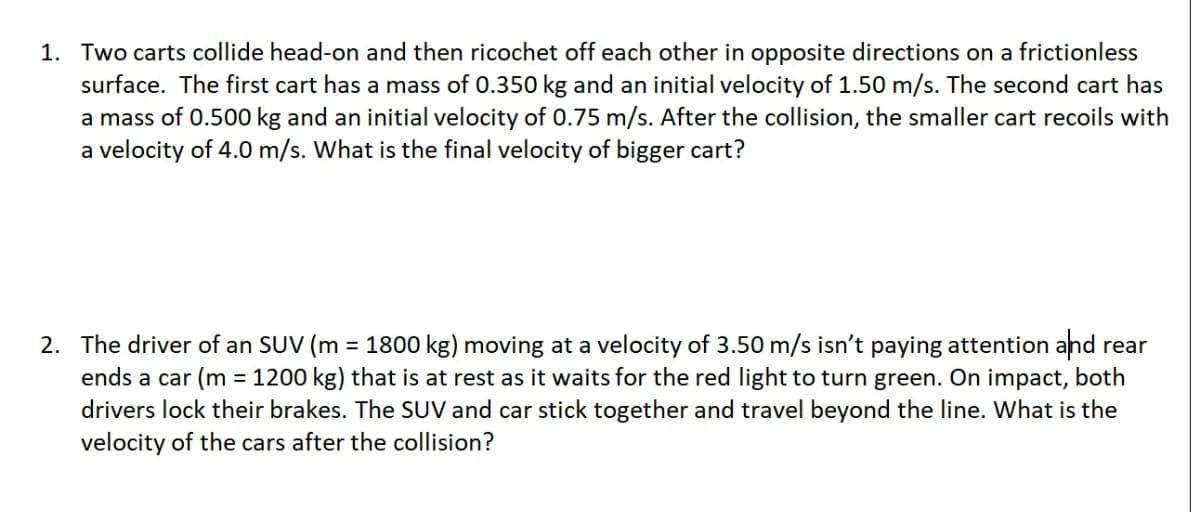ustrate and solve the following problems. Show the complete solution (in GRESA format), always include the SI units on your solution, express your answer in two decimal places and bo
ustrate and solve the following problems. Show the complete solution (in GRESA format), always include the SI units on your solution, express your answer in two decimal places and bo
Principles of Physics: A Calculus-Based Text
5th Edition
ISBN:9781133104261
Author:Raymond A. Serway, John W. Jewett
Publisher:Raymond A. Serway, John W. Jewett
Chapter8: Momentum And Collisions
Section: Chapter Questions
Problem 23P
Related questions
Question
Illustrate and solve the following problems. Show the complete solution (in GRESA format), always include the SI units on your solution, express your answer in two decimal places and box your final answer.

Transcribed Image Text:1. Two carts collide head-on and then ricochet off each other in opposite directions on a frictionless
surface. The first cart has a mass of 0.350 kg and an initial velocity of 1.50 m/s. The second cart has
a mass of 0.500 kg and an initial velocity of 0.75 m/s. After the collision, the smaller cart recoils with
a velocity of 4.0 m/s. What is the final velocity of bigger cart?
2. The driver of an SUV (m = 1800 kg) moving at a velocity of 3.50 m/s isn't paying attention and rear
ends a car (m = 1200 kg) that is at rest as it waits for the red light to turn green. On impact, both
drivers lock their brakes. The SUV and car stick together and travel beyond the line. What is the
velocity of the cars after the collision?
Expert Solution
This question has been solved!
Explore an expertly crafted, step-by-step solution for a thorough understanding of key concepts.
Step by step
Solved in 2 steps

Knowledge Booster
Learn more about
Need a deep-dive on the concept behind this application? Look no further. Learn more about this topic, physics and related others by exploring similar questions and additional content below.Recommended textbooks for you

Principles of Physics: A Calculus-Based Text
Physics
ISBN:
9781133104261
Author:
Raymond A. Serway, John W. Jewett
Publisher:
Cengage Learning

College Physics
Physics
ISBN:
9781285737027
Author:
Raymond A. Serway, Chris Vuille
Publisher:
Cengage Learning

Physics for Scientists and Engineers with Modern …
Physics
ISBN:
9781337553292
Author:
Raymond A. Serway, John W. Jewett
Publisher:
Cengage Learning

Principles of Physics: A Calculus-Based Text
Physics
ISBN:
9781133104261
Author:
Raymond A. Serway, John W. Jewett
Publisher:
Cengage Learning

College Physics
Physics
ISBN:
9781285737027
Author:
Raymond A. Serway, Chris Vuille
Publisher:
Cengage Learning

Physics for Scientists and Engineers with Modern …
Physics
ISBN:
9781337553292
Author:
Raymond A. Serway, John W. Jewett
Publisher:
Cengage Learning

Physics for Scientists and Engineers: Foundations…
Physics
ISBN:
9781133939146
Author:
Katz, Debora M.
Publisher:
Cengage Learning

Physics for Scientists and Engineers, Technology …
Physics
ISBN:
9781305116399
Author:
Raymond A. Serway, John W. Jewett
Publisher:
Cengage Learning

Classical Dynamics of Particles and Systems
Physics
ISBN:
9780534408961
Author:
Stephen T. Thornton, Jerry B. Marion
Publisher:
Cengage Learning